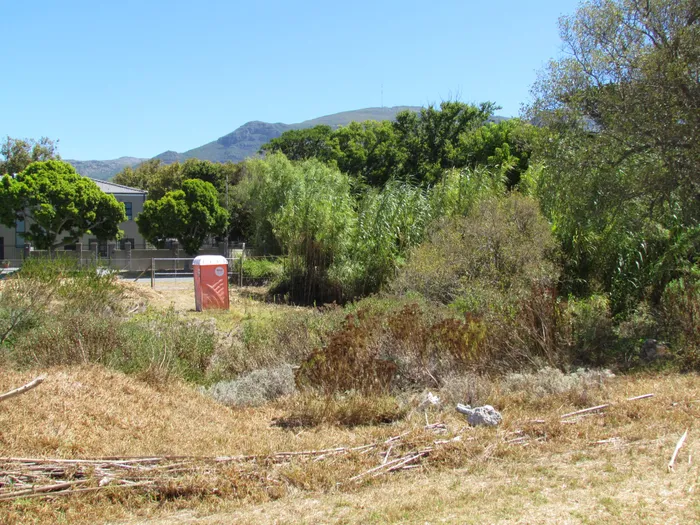A greenbelt under threat

Fencing crosses the Pagasvlei stream and footpaths used by the public.
Constantia valley residents have raised a red flag over part of the Grootboschkloof greenbelt being carved up for a housing development.
They are questioning how property owners in the area came into private ownership of land identified as public open space on City maps.
The remainder of erf 3029 between Strawberry Lane and Willow Road was purchased by Schumacher Real Estate in September for R20 million. The company’s owners are German former racing driver Ralf Karl-Heinz Schumacher and Peter Tauber. They own the neighbouring Villa Coloniale luxury retreat and a B&B in Price Drive. Efforts to contact the owners have been in vain. Villa Coloniale staff said Mr Schumacher was overseas and only returning at the end of the year, and Mr Tauber did not respond to emails and phone messages.
Architect Jaclyn Cattell, who has drawn up designs for a housing development of 13 double-storey houses, a clubhouse and gym, 26 parking bays and three swimming pools, said it was far too early to comment about the development and that residents had “jumped the gun”. She referred us to Karlo Hendriksz, of First Plan Town and Regional Planners, but he did not respond to calls and emails.
Earlier this month, the land was cleared of vegetation and fenced, including across the Pagasvlei stream and Grootboschkloof greenbelt, which is used by the public, according to Maureen Fienberg, who lives in the bend of the L-shaped plot. The greenbelt runs between Spaanschemat River Road and Ladies Mile. About three years ago, a mandala was created on site, with input from the municipality and Wildlife and Environment Society of South Africa (WESSA).
The zoning is split, with one third being single residential (SR1) and the rest open space (OS2).
Strawberry Lane resident Wil Wolter is objecting to the high-density of the development, and he has accused the owners of slotting a gate into his boundary fence for access to the land without any notification.
His neighbours, Richard and Maureen Fienberg, live in the bend of the L-shaped land. They believe that the proposed development is out of keeping with the peaceful, rural feel of the area. They are concerned that there will be an increase in noise and traffic that will disturb the natural habitat and set the wrong precedent for future developments.
Dr Gareth Jones, who has lived in Willow Road for 30 years, said it was not the development that he was opposed to but rather “the total disregard for surrounding neighbours and the veiled communications from the developer and the City which erodes trust”.
Angie Montandon, who has lived in Willow Road for almost 40 years, said she enjoyed the tranquil, green, rural environment rich with flora and wildlife, but the wildlife had been dwindling in recent years.
“When we questioned the sale of this land, we were told it is privately owned. We were also told by our ward councillor that the zoning of OS2 was a ‘glitch’ in the GIS (geographic information system) map software and did not apply to this erf. This has been proven incorrect as even the documents relating to the sale between the developer and the previous owner reflect a zoning of public open space,” said Ms Montandon.
Ward councillor Emile Langenhoven said the zoning of erf 3029 was an anomaly that had rightfully left residents confused and upset.
“I’m still left with questions about what vested interest the City may have in this area, whether environmental, infrastructural or otherwise. I will be pursuing answers regarding the development to get a better understanding and will report back to the community as soon as I am in possession of the facts," said Mr Langenhoven.
The Bulletin sent questions to the City’s planning office about the proposed development and the legality of building a fence, but all they would tell us by deadline was that they were looking into the particulars of our questions.
Dr Raoul Goldberg, who lives across the road from the greenbelt, said he had endured blockages of sewerage and stormwater pipes every three to six months that flooded his property and overflowed into the greenbelt. “It is essential that something be done about this ancient sewerage system if this proposed new development is accepted.”
Botanical ecologist Dr Caitlin von Witt, of FynbosLIFE, said the proposed development threatened the rehabilitation on this section of Pagasvlei stream. Called The Grootboschkloof Fynbos Circle, the rehabilitation is a collaboration between the City, FynbosLIFE and Friends of Constantia Valley Greenbelts. WESSA also contributed towards the signage costs.
Dr Von Witt said more than 70 species had been planted on the land, including three critically endangered and three endangered ones.
“This rehabilitation was designed to support a diversity of insect and bird pollinators as well as near-threatened Cape dwarf chameleons, which breed at the site. This zone is a crucial western leopard toad refuge, foraging area and protected zone for movement to and from the breeding dam 60m downstream from the eastern end of erf 3029.”
The land was also home to a multitude of birds, and before the stream was fenced off, there was weekly evidence of Cape porcupine movement and even the odd visit from a Cape genet, said Dr Von Witt.
The previous owner of the land, Nick Schofield, said he had been born on what was then a working wine farm that his grandfather had bought for 500 pounds in 1917. He said he had no doubt that Mr Schumacher was a man of stature who would create a sympathetic development.



